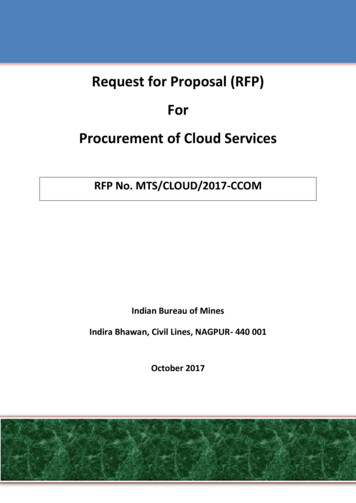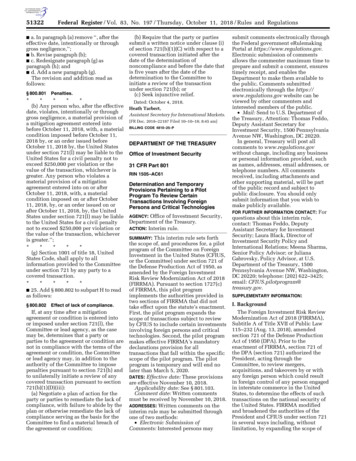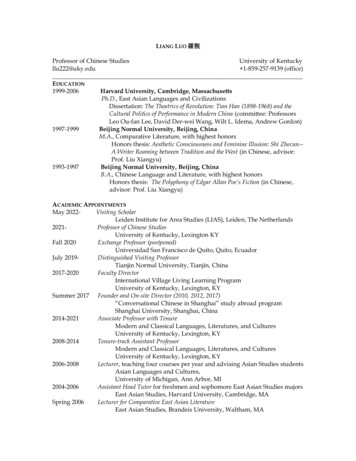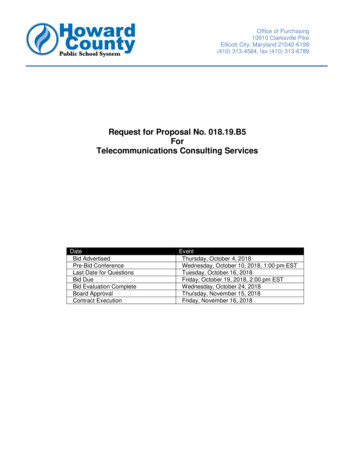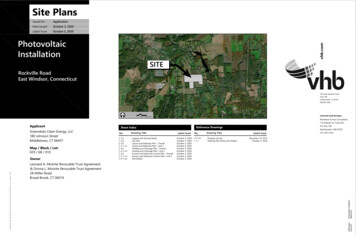
Transcription
Vol. 13, No. 3, October 2005The RT ReviewThe Latest on Environmental Issues From YourSolution-Oriented Environmental Services Firm Environmental Engineers & Scientists Geologists Remedial ContractorsNEW REPORT SHOWS PROGRESSREDUCING AIR POLLUTION INEASTERN UNITED STATES2004 decreases in emissions of ozone formingnitrogen oxides (NOx) signal that ozone air qualitythroughout the eastern US is improving. Accordingto a new report released in mid-August, “EvaluatingOzone Control Programs in the Eastern UnitedStates: Focus on the NOx Budget Trading Program,2004”, EPA’s rule, known as the “NOx SIP Call,”has yielded reductions to improve air quality formore than 100 million people. The NOx SIP Calldirects 21 eastern states and the District ofColumbia to reduce emissions of NOx during thesummer months. All states subject to this rulechose to comply by participating in the EPA-administered NOx Budget Trading Program.“The NOx Budget Trading Program is yet anotherexample of how market-based trading programs aresignificantly reducing emissions of air pollutants,”said EPA Administrator Stephen L. Johnson. TheNOx SIP Call and our new clean Air Interstate Ruleensure that Americans continue to breathe cleanerair by dramatically reducing air pollution that movesacross state boundaries.”The NOx Budget Trading Program was modeledafter the Ozone Transport Commission’s NOxBudget Program an EPA’s Acid Rain Program todeliver important emissions reductions efficientlyand effectively. Under this program, the reportshows that power industry summertime NOx emissions have dropped significantly in 2004. Totalozone season NOx emissions from power plantsand other large combustion sources were 30 percent lower than in 2003, and 50 percent lower thanin 2000. The NOx reductions, when combined withother control programs have reduced ozone seasonNOx emissions from sources in 19 eastern statesand the District of Columbia, by 70 percent below1990 levels.Continued NOx emission reductions are anticipated under the NOx SIP call and the Clean AirInterstate rule, or CAIR. CAIR, issued March 10,2005, will permanently cap power plant emissionsof SO2 and NOx in 28 eastern states and the Districtof Columbia. In 2015, CAIR, the NOx SIP Call andother programs in the East will reduce ozone seasonNOx emissions by about 50 percent and annualNOx emissions by about 60 percent from 2003levels.The new report, “Evaluating Ozone ControlPrograms in the Eastern United States: Focus onthe NOx Budget Trading Program, 2004” is available at: http://www.epa.gov/airtrends. Informationand background on the NOx SIP Call is available athttp://www.epa.gov/airmarkets/fednox.(EPA Press Release – (8/18/05)RTENV.COMNEW GENERATION OF BROWNFIELD SITESRECEIVING TOP ATTENTIONThe next generation of Brownfield sites arealready turning out to be all that planners andthose concerned about the environment wantedto see happen as the nation accommodatespopulation growth. In Pennsylvania and NewJersey, legislatures and governors, several yearsago, created both economic and permit expediting incentives which are now coming to fruition.Now, projects are even being put forth which caninclude transportation infrastructure improvements drawing political public support, a verypositive answer to the “NIMBY” syndrome,which has delayed many projects.Two example projects currently being proposed by Develcom, a Bellmawr, New Jersey,redevelopment organization, include key infrastructure and transportation improvements incongested areas – in suburban Willow Grove,Pennsylvania, and in Bellmawr, New Jersey.Bellmawr, located at the confluence of NewJersey’s North-South freeway (I-76) and I-295has the highest volume freeway “intersection” inthe southern part of New Jersey.The Willow Grove project includes redevelopment of a Willow Grove “main street” area, andmovement and redevelopment of a Home Depotsite. A new “connector road” has been incorporated into the plan, which will provide permanent improvement to traffic conditions in thearea, including better access to the WillowGrove interchange of the PennsylvaniaTurnpike. The Willow Grove project willclearly make “highest and best use of the land”through construction of parking garages immediately adjacent to new retail space, and, the trafficimprovements will improve existing infrastructure, not simply make use of it.The Willow Grove site has a number of environmental issues to deal with, which are beingevaluated by RT Environmental Services as partof redevelopment plans.The Bellmawr project involves a larger sitewith three former landfills, greater than 100acres in size. Although clay materials underlaythe landfill sites, the landfills were not closed inaccordance with modern environmental regulations. A Memorandum of Agreement hasalready been entered into between Develcomand the New Jersey Department ofEnvironmental Protection, to investigate this siteand to make sure that any remaining areas ofenvironmental concern associated with thelandfill are addressed as part of the redevelopment process.Page 1Redevelopment of the Bellmawr site poses anumber of challenges, including that a connectorramp between the North-South freeway and I295 is proposed to be installed in the near futureacross the site as part of the New JerseyDepartment of Transportation’s “MissingMoves” project. Bellmawr’s long-time mayor,Joseph Petruzzi, has called for proper closure ofthe landfill as part of any aspect of site redevelopment. Recently, New Jersey TransportationCommissioner Jack Latierre, and Develcomprincipal, Charles Gallub, agreed that, by working together: Proper closure of the landfill can beachieved. Integrated drainage solutions can be implemented providing state of the art stormwatercontrols, and protecting nearby Big TimberCreek. The congested areas of Bellmawr near theCreek Road exits can be improved, by construction of by-pass roads, improving existing trafficbackups.The Camden Courier Post also recently featured the project in a headline story, indicatingthat the site may be South Jersey’s first “transitvillage.” This possibility depends on the selection of PATCO High Speed Line expansionroutes as two of the planned routes, would gopast the site. Develcom has offered free spacefor a new rail station, should either of the routeswhich would traverse the site near the NorthSouth freeway, be selected.Although a “transit village” is a new conceptto South Jersey, transit villages have receivedconsiderable attention in Pennsylvania andNorth Jersey. Located mostly at commuter railstops, transit villages typically have a mix ofcommercial and residential uses, and frequentlyresidents to go to their jobs without the use ofcars. Transit villages are considered a keyelement in helping to revitalize America’s citiesand near suburban areas. Implementation of atransit village approach at the Bellmawr site hasbeen well received initially, and improvedconnections to New Jersey Turnpike Exit 3 are(continued on page 2)TABLE OF CONTENTSStaff and Project News . . . . . . . . . . . . . . . . . . . 3PA Updates . . . . . . . . . . . . . . . . . . . . . . . . . . . . 4Technology Updates . . . . . . . . . . . . . . . . . . 6-11Federal Regulatory Updates . . . . . . . . . . . 12-20NJ Updates . . . . . . . . . . . . . . . . . . . . . . . . . . . .22
Vol. 13, No. 3, October 2005DirectoryCorporate Headquarters215 West Church RoadKing of Prussia, PA 19406Phone: (610) 265-1510FAX: (610) 265-0687E-mail: RTENV@AOL.COMWorld Wide Web: HTTP://RTENV.COM24 HOURURGENT LINE SERVICE800-725-0593Gary Brown, P.E., PresidentPhone: (610) 768-0232E-mail: GBROWN@RTENV.COMRich Johnson, P.G.Phone: (610) 265-1510 Ext. 11Hydrogeology Group ManagerE-mail: RJOHNSON@RTENV.COMWalter HungarterPhone: (610) 265-5599Engineering Group ManagerE-mail: WHUNGARTER@RTENV.COMRob CareyPhone: (610) 265-1510 Ext. 31Remediation Group ManagerE-mail: RCAREY@RTENV.COMMark Eschbacher, P.G.Phone: (610) 265-1510 Ext. 32Senior HydrogeologistE-mail: MESCHBACHER@RTENV.COMNew JerseyJustin LauterbachPhone: (856) 467-2276 Ext. 119E-mail: JLAUTERBACH@RTENVNJ.COMSuite 306, Pureland Complex510 Heron Drive, P.O. Box 521Bridgeport, NJ 08014Phone: (856) 467-2276FAX: (856) 467-3476Regional PartnersCaliforniaBob SmythPhone: (856) 234-1730FAX: (856) 234-4387MassachusettsAndy IrwinPhone: (508) 653-8007FAX: (508) 653-8194MichiganMichael CarlsonPhone: (248) 585-3800FAX: (248) 585-8404North CarolinaPhil RahnPhone: (336) 852-5003OhioRon ClarkPhone: (330) 375-1390 Ext. 207VirginiaEdward BergPhone: (757) 599-6985FAX: (757) 599-3501NEW GENERATION OF BROWNFIELD SITESRECEIVING TOP ATTENTION (continued from page 1)also under study.Under a Remedial Investigation Work Plan,RT Environmental Services is currently completing an in depth environmental study of the site,which is clearly unique. Attention is being givento the Big Timber Creek estuary, which is likelyto see water quality improvements as a result ofthe project. Water quality testing is currentlyunderway, and an environmental objective associated with the site redevelopment is to carefullyassess current groundwater and surface waterquality to assure that future improvements,which are expected to include capping of muchof the site are properly designed and implemented. Already, a major retailer has expressed interest in a portion of the site, and another, focusedon residential development has expressed stronginterest as well. Early site inspection and historical data review results suggest that New JerseyDEP’s long-standing Coastal Area FacilitiesReview Act and Wetlands Protection Programhistorically protected the Big Timber Creek estuary from early sprawl development impacts, asthe area of active wetlands remains very large,compared nearly all other New Jersey orPennsylvania estuaries. It is anticipated that withproper closure of the three landfills, further waterquality improvements will occur.As the metropolitan areas in the northeasternpart of the U.S. rediscover their “river historicalroots,” proper development in estuary areas,while addressing past environmental impactsfrom filling activities, enhances overall environmental protection.RT is also working on another Big TimberCreek estuary site in Westville, where, thePennsylvania Railroad established a power plantin the early part of the 20th Century to feedpower to an electric rail line serving Woodbury,Millville, and Atlantic City. The power plant hadasbestos issues, but, the plant was properly abated and demolished when Conrail assets werepurchased by CSX and Norfolk Southern railroads. Redevelopment of this site, wouldinvolve a number of remediation aspects as well.Similar to portions of the Bellmawr site, theWestville site would also be considered for residential redevelopment, making maximum use ofexisting infrastructure, and construction of midand/or high-rise buildings.Yet anotherBrownfields riverfront site is close to approval inthe Vineland/Millville area.RT appreciates the trust our clients place in usas better and better Brownfields site redevelopment projects are concepted and move tofruition. Both key states we operate in,Pennsylvania and New Jersey, have taken important steps in the last year to make sure thatBrownfield projects receive proper attention; Mr.Kenneth Kloo is effectively managing brownfields efforts at the New Jersey Department ofEnvironmental Protection, and the LandRecycling Program in Pennsylvania has beengive a new leader, Mr. Eugene DePasquale.These important leadership efforts in both statesmeans that Brownfields site projects will receivethe attention they deserve, at the highest level ofeach state’s Department of EnvironmentalProtection.Should you need any further information onBrownfields initiatives, contact Gary Brown inour King of Prussia office, or Justin Lauterbachin our New Jersey Office. As always, we appreciate the opportunity to be of service.PCB REMEDIATION WASTE REGULATORYCHANGES UNDER CONSIDERATIONCongress directed the Office of Management andBudget (OMB) to prepare an annual Report to Congresson the Costs and Benefits of Federal Regulations. OnFebruary 20, 2004 (69 Fed. Reg. 7987), OMB made thereport “2004 Draft Report to Congress on the Costs andBenefits of Federal Regulations” publicly available andrequested public nominations of regulatory reforms. Oneof the nominations that OMB received was from theUtilities Solid Waste Advisory Group (USWAG). (See,USWAG letter dated May 20, 2004, to Ms. Lorraine Hunt,OMB, subject: Draft Report to Congress on the Costs andBenefits of Federal Regulation; Notice and Request forComments.) It contends that in two different sections ofthe PCB regulations at 40 CFR §761.61, EPA treats identical PCB remediation waste at concentrations less than50 parts per million (ppm) differently. (See, Comment I.,in USWAG May 20, 2004, letter of OMB.) USWAG furthercontends that the regulations at 40 CFR 761.61 and 40CFR 761.50(b)(3)(ii) state that all PCB remediationwaste containing less than 50 ppm PCBs can be disposed of based on it as-found concentration in a municipal solid waste landfill. EPA is reviewing the regulationsto determine whether they should be clarified andstreamlined to minimize any potential confusion and ifso, how.The regulations and policy being reviewed include: 40CFR 761.61; 40 CFR 761 Subpart G (PCB Spill CleanupPolicy); and 40 CFR 761.50(b)(3)(ii).Page 2EPA is considering whether to reorganize the cleanupregulations, for instance, by integrating the PCB SpillCleanup Policy into the PCB remediation regulations, separating the disposal provisions from the cleanup provisions, providing clarification on the applicability of thecleanup regulations, and identifying a sub-set of PCBself-implementing cleanups and disposals that will nolonger be subject to EPA approval. In general, EPA hasrequested comments from stakeholders on the followingissues:- Whether the regulations pertaining to PCB remediationwaste need to be clarified and if so, how can EPA clarifythem?- How should the regulations be organized to betterclarify the disposal requirements for cleanups under 40CFR 761.61(a) and the disposal of PCB remediationwaste under 40 CFR 761.61(b)?- Are there other regulations other than those discussedabove that should be changed to improve the regulationsthat relate to PCB remediation waste?- Can the regulations be modified or organized in otherways that would make them easier to use and moretransparent?- Whether there are self-implementing cleanups and disposals that need not be subject to EPA review? If so,what are the characteristics of these sites?(USEPA – 7/21/05)
The RT ReviewEPA TESTS QUICK DEMOLITION METHOD LEAVING ASBESTOS IN PLACEThe closed U.S. Army base Fort Chaffeehas been identified by the U.S.Environmental Protection Agency as thesite for the testing of a new AlternativeAsbestos Control Method, which wouldlower the restrictions on demolition ofbuildings that contain asbestos. Not all theasbestos would have to be removed beforedemolition under the new method.The Alternative Asbestos ControlMethod removes only the most friable, orbrittle, materials containing asbestos beforedemolition, but leaves some asbestos containing materials, such as wall systems, inplace.The most friable asbestos-containingmaterials are removed under the requirements of the Asbestos National EmissionsStandards for Hazardous Air Pollutants(NESHAP) and are disposed of as asbestoscontaining wastes.Once the most friable materials are safely removed, the demolition proceeds usingamended water suppression before, during,and after demolition, in order “to trapasbestos fibers and minimize their potentialrelease to the air,” the EPA said.Wastewater generated during the demolition is collected, and all contaminated materials are disposed as asbestos-containingwaste. A two-inch layer of soil is removedto ensure that no residual soil contamination remains at the site.The new method “may serve as analternative to the current NESHAP fordemolition of buildings containingasbestos,” the EPA said.The agency says the new method may“accelerate the demolition of many abandoned buildings around the nation thatremain standing, currently presenting avariety of serious risks to nearby residents.”“Using the Alternative Asbestos ControlMethod, these former blighted areas wouldthen be available redevelopment, creatingjobs and tax revenues for communities,”said the agency.The demonstration will include environmental monitoring, and will allow for arepresentative of the city, Arkansas HealthDepartment, or the EPA to stop work if conditions so merit, the federal agency said.The site is in a remote, secure location, toassure no public exposure, and has severalidentical structures with asbestos-containing building materials to facilitate a sideby-side comparison of the AlternativeAsbestos Control Demolition method vs.the current NESHAP method.The buildings have a clearance ofapproximately 1,000 feet from the nearestoccupied site on the eastern side, and morethan that in all other directions.The project will be carried out as a jointeffort of the Fort Chaffee RedevelopmentAuthority, the Arkansas Department ofEnvironmentalQuality,theU.S.Department of Energy, and the EPA.“Public involvement of local residentswill be solicited at various stages throughout the project, and will be an integral partof the project plan,” the EPA said.(Environment News Service – 8/8/05)RT STAFF AND PROJECT NEWSAs of mid fall more Brownfields site work was continuing to dominate RT’s project agenda. Work at an additional servicestation/petroleum release site in Cumberland County was underway, to be managed by Justin Lauterbach, General Manager of RT’sNew Jersey Office. A new Act 2 site, with impacted groundwaterfrom former wood preserving operations was also underway inLower Bucks County, PA, being managed by Mark Eschbacher,P.G.Gary Brown obtained his NJDEP Cleanup Star Certification,which is being put to quick use for a Tech Rules PreliminaryAssessment of a 90 acre cranberry bog site in Burlington County.Dave Carlson, lead hydrogeologist in RT’s New Jersey Officeassumed responsibility for project management of a Brownfield siteinvestigation of a former petroleum research site, near the NewJersey Turnpike in the Central part of New Jersey. A large number of areas of concern are being investigated by former owners,with minor areas of concern being investigated by the purchaser,RT’s client.Rob Carey and Thomas Donovan are tackling a remedial projectin Winslow, where a significant amount of debris and waste wasfound to be present at a former landscaping company site scheduledfor residential development. Larry Bily and Benjamin Shaw continue to work at the Budd Commerce Center Site in Philadelphia,and the American Metro Brownfields redevelopment site, nearTrenton, NJ. Also assisting on both projects, and implementingstate of the art PCB well and floor sampling techniques is ScottHazelton.Chris Ward and Shane Dorward are implementing a North PennArea Brownfields site investigation involving former undergroundstorage tank area release and a large concrete material waste pile,prior to planned purchase and redevelopment.A number of new employees have joined RT to meet a strongclient demand, at our many project sites.New employees include: Gina Testa, who has a BS Degree in Biology from PhiladelphiaUniversity. Gina has previous regulatory experience, as well as nce. Teresa Andres, joined RT with a Masters Degree from RowanUniversity. Teresa is already hard at work on Phase IEnvironmental Site Assessments, including a preliminary assessment and soil sampling at a former cranberry bog site in EveshamTownship, NJ. Robert McKenzie, joins RT with 17 years of experience inasbestos testing and abatement oversight. Bob has an AssociatesDegree from Miami Dade Community College. Dave Carlson, joins RT’s New Jersey Office as leadHydrogeologist. Mr. Carlson is an NJDEP closure subsurface evaluator, and is a Professional Geologist in Pennsylvania. Dave has aBachelor of Arts Degree in Geology from Franklin and MarshallCollege. Ben Shaw, joins RT as an Environmental Engineer working inWalter Hungarter’s King of Prussia Engineering Group. Ben isworking on preparing Contingency Plans for asphalt plants, and on/Brownfields Site, in Philadelphia. Ben is a StevensInstitute of Technology Graduate. Shane Dorward, joins RT in Rob Carey’s Remediation Groupin our King of Prussia Headquarters. Shane has a Bachelor ofScience Degree in Environmental Studies from Temple University,where he graduated with honors. Shane is currently completing anumber of soil and groundwater investigation projects at Brownfieldsites, as well completing Phase I Environmental Site Assessmentwork. John McCabe joined RT’s NJ Office as environmental engineer, reporting to Joe Lang. John is a Penn State Graduate with adegree in Environmental Systems Engineering.RT is very proud of our new staff, and we look forward to theopportunity to continue to be of service to our clients who continueto award us many new and exciting projects.Page 3
Vol. 13, No. 3, October 2005PA UPDATESAMOUNT OF WASTE DEPOSITED INPA LANDFILLS DOWN FOR THIRDCONSECUTIVE YEARThe Department of Environmental Protectionreported that the total amount of waste disposedof in Pennsylvania landfills dropped for the thirdconsecutive year, decreasing from 25.39 milliontons in 2003 to 25.18 million tons last year.(DEP Update – 7/20/05)PENNSYLVANIA GIVES 5.5 MILLIONFOR OPEN SPACE, RECREATIONPennsylvania Governor Edward Rendellannounced 5.4 million in grants to undertake 47local and regional greenways, open space, community park and recreation projects in 30 counties across Pennsylvania.“Through our partnership grant program, Ihave focused on giving Pennsylvania communities the helping hand they need to become morevibrant places to live, work and plan,” GovernorRendell said.“We have a number of different grants that weprovide to allow urban and rural communities todevelop their streetscapes, promote outdoorattractions and develop plans that will ultimatelycreate a more efficient and pleasurable use ofgreen space.”Statewide, the grants will fund a variety ofopen space acquisition, greenways and community park and recreation projects, includingacquisition of 18 tracts and the protection of1,291 acres.The largest grant of 500,000 went toWillistown Township in Chester County foracquisition of approximately 10 acres adjacent toWest Chester Pike and Delchester Road forpreservation of open space and natural areas forthe Okehocking Preserve.An Urban Audubon Center in Philadelphiawill be explored and development plans for sixparks in Williamsport will be funded.The Community Conservation PartnershipProgram grants are funded through the stateDepartment of Conservation and NaturalResources by Growing Greener, Keystone ’93and federal funds.For more information and a complete list ofthe grants by count, visit www.dcnr.state.pa.us,and select “grants.”(Environment News Service –8/29/05)PENNSYLVANIA FACILITIES MUSTMONITOR DISCHARGES TOCHESAPEAKEPennsylvania is imposing new monitoringrequirements for 190 sewage and industrial discharges as part of the state’s Chesapeake BayTributary Strategy, Environmental ProtectionSecretary Kathleen McGinty announced.The Chesapeake Bay Tributary Strategy is awide-ranging water quality initiative designed toclean up the state’s rivers and streams, enhancethe health of families and preserve the rural character and farming economy of Pennsylvania.The watersheds of the Susquehanna andPotomac rivers in Pennsylvania suffer fromnutrient and sediment pollution. The tributarystrategy is expected to improve water quality inthe 13 sub-basins that make up these two watersheds.“This is an important step toward restoringimpaired waters in Pennsylvania and theChesapeake Bay – requiring 190 significantsewage and industrial discharges to reduce theirnutrient loads,“ McGinty said. “Monitoringnutrient loads is critical to documenting ourprogress in the Bay restoration effort and helps toidentify steps each discharger may need toundertake to achieve any future nutrient loadreductions.As part of the Chesapeake 2000 Agreementamong Bay states and partners in the restorationeffort, Pennsylvania agreed to develop a tributarystrategy to reduce total nitrogen and phosphorusto the Bay by about 40 percent from both pointand nonpoint sources by 2010.As part of the point source part ofPennsylvania’s strategy, DEP is amendingNational Pollutant Discharge Elimination System(NPDES) permits for 190 facilities identified tobe significant contributors of nutrients. Permitswill be amended to require the monitoring andreporting of total nitrogen and phosphorus. Thisis the first component of the point source implementation strategy.Point source discharges contribute about 11percent of the total nitrogen and about 18 percentof the total phosphorus to the Chesapeake Bayfrom Pennsylvania waters based on 2002 estimates.Full implementation of the point source control program will achieve an estimated reductionof 3.1 million pounds of nitrogen and 745,000pounds of phosphorus per year.(Environment News Service –8/8/05)EPA ADMINISTRATOR LAUDSINNOVATIVE PROGRAM INPHILADELPHIAEPA Administrator Stephen L. Johnson cited aPhiladelphia initiative as a national model forreclaiming and managing vacant urban lots.In a city tour of formerly abandoned sites,Administrator Johnson saw how sites have beenconverted from rubble to green spaces lush withgrass and shade trees. Although the spaces areoften small, by reclaiming many sites in the areaof North Philadelphia, the abandoned lots havebeen converted into green corridors.“This community-driven partnership hasturned urban blight into urban pride,” saidAdministrator Johnson. “The environmental andeconomic results achieved here in Philadelphiaare a model for communities across the countryand will be showcased by the White House at theConference on Cooperative Conservation in St.Louis this month.”The tour was hosted by J. Blaine Bonham, Jr.,executive vice president of the PennsylvaniaHorticultural Society (PHS). Guest included representatives from the city’s NeighborhoodTransformation Initiative and the PhiladelphiaWaste Department.The vacant land program is run by thePennsylvaniaHorticulturalSociety’sPage 4PA UPDATES Philadelphia Stormwater Award, Pg. 4 Porous Pavements, Pg. 4 Chesapeake Discharge Monitoring, Pg. 4 Toxics Management Strategy, Pg. 5Philadelphia Green program and is a part of thehorticultural Society’s “Green City Strategy.”One of the key advantages of investments ingreening and in vacant land management is theincrease in property values by as much as 30 percent.This fact was reported in “TheDeterminants of Neighborhood Transformationin Philadelphia – Identification and Analysis,” astudy undertaken by the Wharton School of theUniversity of Pennsylvania’s Real EstateDepartment with support from the William PennFoundation to look at revitalization strategies andtheir impact on neighborhoods.The program started as a greening program torenew small spaces in neighborhoods, one stepat-a-time. Now PHS has added a storm watermanagement component, turning spaces thatwere neighborhood eyesores into places that nowbeautify the neighborhood, also providing shadeand environmental benefits. To learn more aboutthis program en/index.html.(EPA News Release – 8/2/05)POROUS PARKING LOTS EASESTORM WATER DAMAGE INPENNSYLVANIAA new parking area paved with a permeablecovering has replaced an impervious surface on amunicipal lot where oil and other residue fromvehicles would accumulate and then wash intoBaker Creek when it rained or snow melted.Kelly Burch, Northwest regional director withthe Pennsylvania Department of EnvironmentalProtection, visited the newly surfaced municipalparking lot in North East Borough last week.The project was financed through a 150,000Growing Greener grant from the state ofPennsylvania.“Paved surfaces like parking lots interrupt thenatural recharging of groundwater,” Burch said.“That can lead to contamination, erosion and themuddying of streams when we have heavy rainfalls that cause a lot of runoff. This project willsignificantly cut back on urban-related pollutionentering Baker Creek, which runs alongside theparking lot.”Growing Greener has helped to develop fiveporous pavement parking lots in Erie County,providing examples for future pavement projectswith the goal of reducing storm water runoff andeliminating or reducing the need for stormwaterdetention.The Baker Creek Watershed Associationreceived the grant to create 320 feet of newstreamside buffer, nearly 8,000 square feet ofgreen space, 340 square yards of infiltration galley and 1,350 square yards of pervious parkingservice in the center of the downtown.In addition, roof runoff from surrounding business building was captured and redirected into
The RT ReviewPA UPDATES (Continued)infiltration galleys to eliminate the surface flushing effect.In addition to the permeable surface that willallow precipitation to be filtered as it percolatesinto the ground, native plants and a bioretentionarea are being installed to further improve theecological functioning of the area.Other permeable pavement lots in Erie Countyare at the Asbury Woods Trail head, the ErieCounty Conservation District, Unitarian Churchand Bayfront Center for Maritime Studies.(Environment News Service –7/19/05)PENNSYLVANIA DENTISTS AGREE TORID THEIR OFFICES OF MERCURYPennsylvania dentists and the stateDepartment of Environmental Protection (DEP)have launched a new partnership to review voluntary best management practices for mercurybearing amalgam wastes and collect obsoletesupplies of elemental mercury to prevent thematerial from entering the environment.“This marks a major accomplishment inefforts to ensure a cleaner, healthier environ
and other large combustion sources were 30 per-cent lower than in 2003, and 50 percent lower than in 2000. The NOx reductions, when combined with other control programs have reduced ozone season NOx emissions from sources in 19 eastern states and the District of Columbia, by 70 percent below 1990 levels. Continued NOx emission reductions are antici-pated under the NOx SIP call and the Clean .



